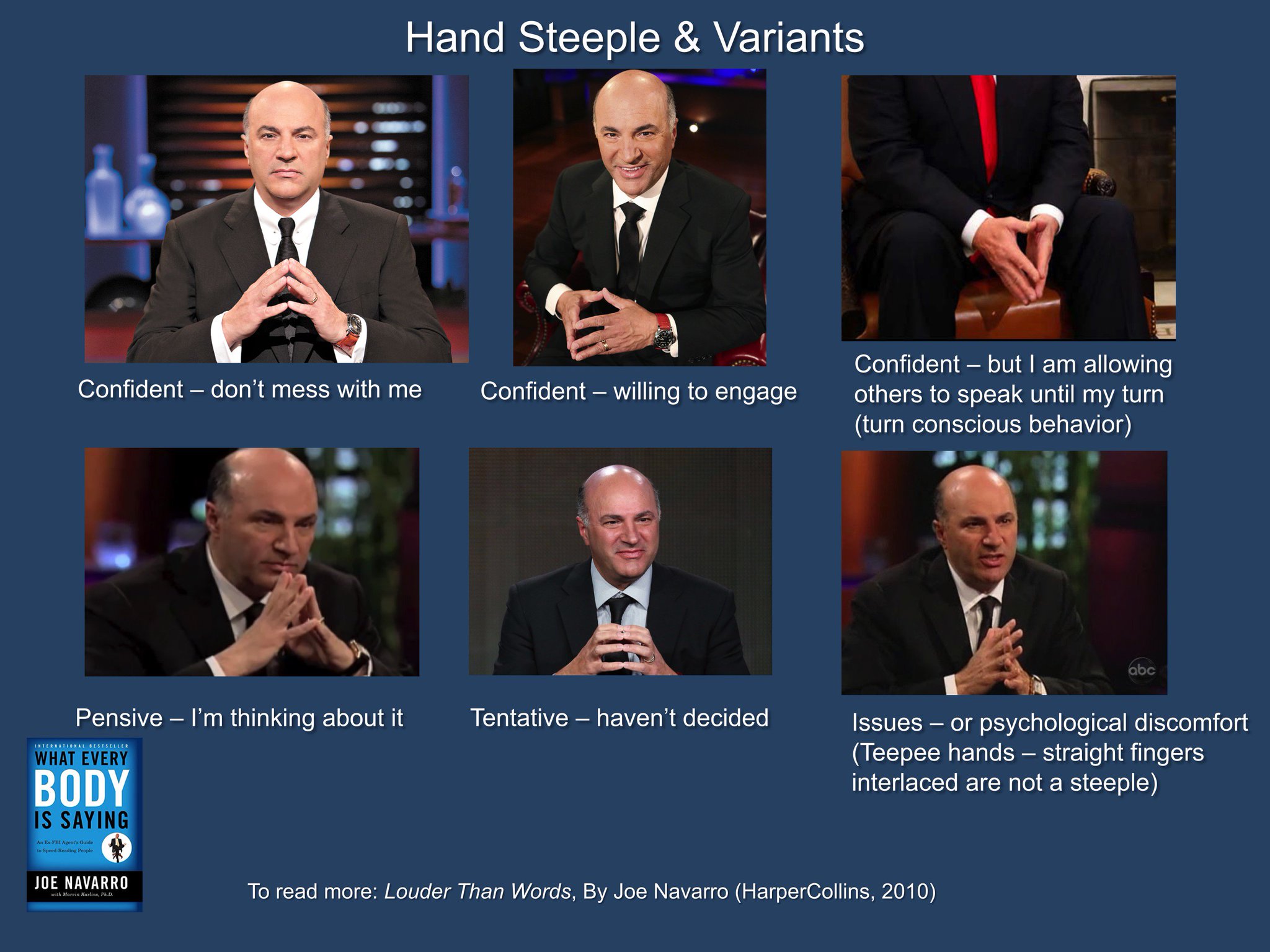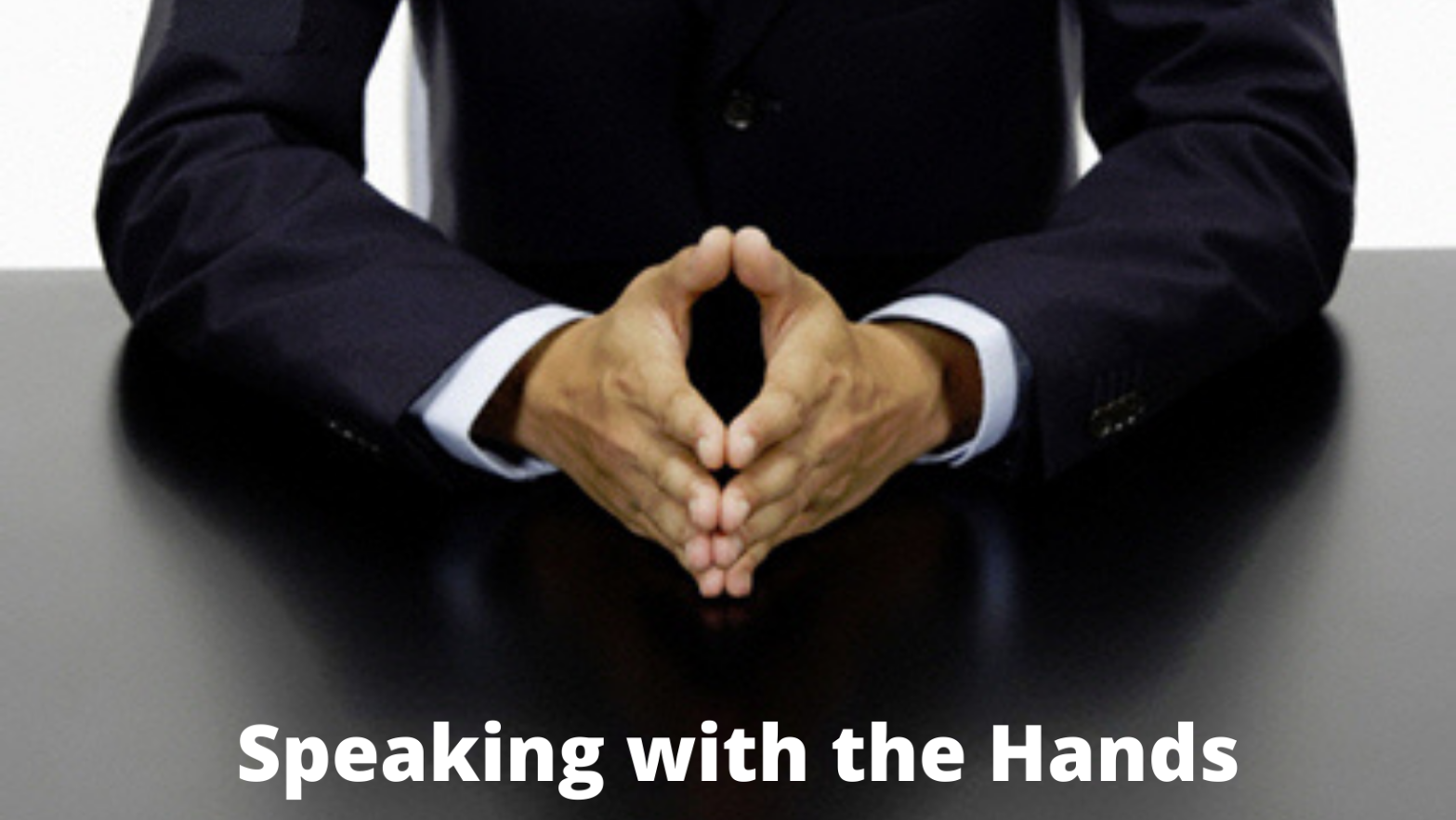Our hands and fingers can be another tell of what is inwardly going on. A person that may be pensive or deep in thought may rest their chin on their hand. A person experiencing stress or exasperation may rub the bridge of their nose.

Sign language is a great example of how our hands can express what we are saying.
Military and militant groups use certain hand gestures to indicate respect or authority. Different handshakes can signify that someone is an initiate or member of that group.
Touching with hands.
Emotion and personalities can be expressed through the way of touching other people. The majority of people that feel familiarity with another person will hug that person. Whereas, people that we don’t feel comfortable with or dislike, that person will stand further back, subconsciously avoiding contact.
The quicker the hug, the less comfortable that person is with another person. Likewise, a one-arm hug can signal discomfort, dislike, or distraction.
A person may touch another trying to emphasize their point, perhaps leaning over

and touching a person’s arm. The light touch of fingertips generally signifies a moderate comfort level. Whereas, a full touch of the palm shows a more significant level of comfort.
The Significance of Hiding the Hands.
Hiding the hands can be indicative of someone attempting to hide something from you, or the person they are talking to. You can closely examine a person in conversation, and if they suddenly withdraw their hands, something has made them withdraw emotionally.
Subconsciously when another hides or withdraws their hands, the other person is more likely to be suspicious of them. If you want a person to trust you, it is important to make sure your palms are in full view.
Quivering Hands.
The muscles of the hands may quiver or shake due to a person being aroused, nervous, or stressed. Hands may shake when a person feels threatened, stressed or angry.
When a person’s hand is quivering, that person will most likely attempt to hide their hands from view, indicating stress or discomfort.
It should be kept in mind that quivering hands isn’t just due to negative emotions. A person’s hand may shake when they are about to propose marriage. Although happy, the action is still stressful.
Any body language needs to be kept in context, and it is more about a person deviating from their baseline behavior. It is important to factor in all ‘tells’ when trying to uncover things.
Comforting Behaviors.
People will use certain behaviors to try and pacify their inner emotions. Adults may wring their hands, rub palms together, or rub palms on thighs in order to comfort

themselves from something that is occurring.
Pointing Fingers.
It is considered one of the most offensive hand gestures. A person will respond more favorably if the palm is out flat, and gesturing to the desired location.
Temperature of the Hands, and the Relevance of the Handshake.
A firm handshake typically sends a message of confidence. A harsh handshake could demonstrate dislike, or an intense need to make a strong impression to the other person.
In most situation when a hand is warm it means blood is flowing to the hand, indicating a certain level of comfort. In contrast, a cold hand may mean blood is flowing away, so can indicate a certain level of stress.
However, some also may have bad circulation, which can result in cold hands.
The Expression of the Fingers.
When a person feels confident they tend to take up more space. People will spread their arms, and stand up straight. Our fingers will also display this inner confidence by steepling their fingers — spreading their fingers out, touching them tip to tip with space in between them.

However, if a person interlocks their fingers with palms touching, less space is displayed, thus indicating discomfort or concern.
Fingers are a perfect example of language deviation. If you observe a person with steepled hands, and a certain type of conversation takes place, you notice the hands come together and interlock. This can show that something that has been discussed has made this person feel uncomfortable.
Grooming Behaviors.
People also need to consider the impact of their grooming. Length of nails, tattoos, jewelry and clothing give off certain impressions of people.
If a person wants to make a good impression, hiding tattoos, and wearing appropriate clothing make a more positive impact.
A person with short nails may indicate a nervous or stressed personality, resulting in them picking or biting their nails.
Picking off lint or getting dirt from under fingernails can demonstrate a lack of interest or respect, a certain dismissiveness of what is being said.
Shielding.
Often people will use their hands to shield or cover up a certain spot on the body when they are stressed, anxious, or hiding information.

A person may hide their eyes when they hear disturbing news. Or a person may rub their nose when they are distressed, or pulling away in thought.
Another example of shielding is when a person covers the chest or neck with their hands, subconsciously protecting a vulnerable area during stress.
A nervous wife may cover the base of the neck/throat when her husband asks her if she is cheating. She may fidget with her necklace, hand covering the area.
In contrast, if a woman does not display this shielding behavior when she’s talking about being abused by her husband, this may indicate she isn’t under emotional stress, or could be lying.
If a woman is emotionally engaged in the story she is telling, it is most likely she will cover her throat or chest. Covering the neck is one of the most common indications that something is wrong.
Additionally, when people are under stress they may cover their torso by crossing their arms.
Men may straighten their tie or pull at their shirt near the neckline, women putting their hand on their throat, or fiddling with something that is close to their neck.
As with everything, clusters of ‘tells’ requires a person to put into context what is happening in order to discover the actual facts.
Universal Body Language
Body language is mainly universal; however, in some cultures certain hand gestures can indicate other things.

The ‘thumbs up’ gesture is usually considered a positive thing. In Iraq, Iran, Greece, West Africa and Russia it is considered an insult.
The ‘ok’ sign in which index finger and thumb meets is considered offensive in
Brazil. Thus, it’s important to properly research the different cultures when you are travelling to avoid offense.
Encouraging Confidence.
It is important when trying to display confidence that the hands and other areas of the body are open. If a person steeples their hands, but they are not visible to other people, that confident action is not noticed.
Our body language can be used in a variety of ways to avoid giving off certain signals. Even general gestures can help to encourage comfort and confidence.
Change Emotions.
Body language can also help to change emotions as it can be used to communicate

to the brain to change the way you feel. In many occasions, when we change our body language, this will help to influence the brain to then bring about more positive emotions.
Understanding your own body language and how to use it in different situations goes a long way to open up more possibilities, and to achieve the outcomes you desire.
